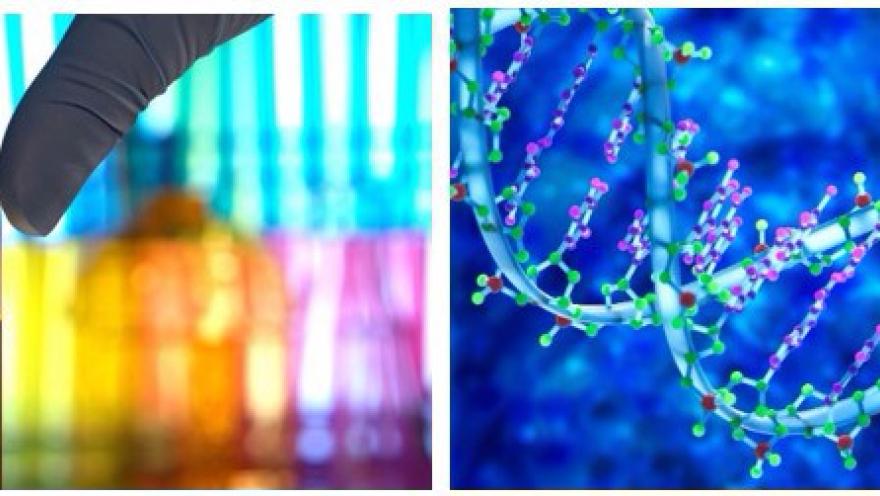Last month, Dr. Leonard Petrucelli at Mayo Clinic Jacksonville in Florida and colleagues reported discovering a new ALS biomarker that specifically detects a protein made by the C9orf72 expansion, the most common inherited cause of ALS. Their results are crucial to complement an upcoming clinical trial testing antisense drugs targeting the C9orf72 expansion. The ALS Association supported this study, including funding to bright, young scientists that significantly contributed to this project – past and current Milton Safenowitz Postdoctoral Fellows, Drs. Tania Gendron, Marka van Blitterswijk, Veronique Belzil, Mercedes Prudencio from the Mayo Clinic Jacksonville and Clinical Research Fellow, Dr. Lindsey Hayes from Johns Hopkins University. The paper with Drs. Tania Gendron, Jeannie Chew, Jeannette Stankowski and Lindsey Hayes as co-first authors, along with 78 contributing researchers, was featured on the Science Translational Medicine front cover of the March 29th issue, which is a great scientific honor.
“These findings have important implications for clinical trials for ALS caused by the C9orf72 repeat expansion,” affirms Dr. Petrucelli, “as they indicate that poly(GP) in CSF can serve as a biomarker to dynamically track the effectiveness of therapeutic strategies aimed at reducing repeat products.”
Top: Drs. Leonard Petrucelli and Tania Gendron; Bottom (left to right): Drs. Marka van Blitterswijk, Veronique Belzil and Lindsey Hayes
C9orf72 repeat expansion
In 2011, an expansion of a short, repeating segment of DNA in the C9orf72 gene was discovered as the most common genetic cause of ALS and frontotemporal dementia (FTD). Normally, a person has approximately 30 repeats, whereas a C9orf72 expansion carrier has several hundreds to thousands of repeats.
Since its discovery, researchers have been working furiously to understand how it causes disease. Potential disease pathways include loss of the gene’s function and the gain of a toxic function stemming from the expanded repeats. The latter produce repeat RNA which causes havoc in cells by disrupting the transport of molecules in and out of the cell nucleus. Also, protein is made from the repeat RNA by a special mechanism called, repeat-associated non-ATG (RAN) translation, producing “dipeptide repeat proteins,” some of which have toxic properties. This study focuses on the “poly(GP)” dipeptide repeat protein.
Biomarkers
Biomarkers are any measurable substance in the body that can be tracked over time. Examples include chemical changes in the blood, cerebral spinal fluid (CSF) and urine. They are extremely valuable to improve ALS diagnosis, track and predict disease progression, monitor a person’s response to therapy and understand whether a drug hits its intended target.
Here, Dr. Petrucelli and colleagues found that poly(GP) protein is a potentially suitable biomarker to track the effectiveness of therapies aimed at reducing C9orf72 repeat products using an antibody-based test for poly(GP) detection. Poly(GP) was readily detected in the CSF of people with ALS harboring a C9orf72 expansion but not in people without this mutation. Interestingly, detectable levels of poly(GP) were also found in asymptomatic C9orf72 expansion carriers, increasing its value as a biomarker.
Antisense Drugs
Antisense oligonucleotides (ASOs) are a type of drug that prevents toxic RNA, and thus proteins derived from this RNA, from being made in cells, thereby shutting off toxicity. The Association has supported ASO technology since its inception in 2004. Currently, there is an ongoing phase I/II trial targeting SOD1, the second most common genetic form of ALS. ASOs have shown great promise in the recent FDA approval of SPINRAZATM, an antisense drug designed to treat spinal muscular atrophy (SMA), a common genetic disease in children.
Here, the investigators applied the poly(GP) biomarker to ALS models to understand whether it could be used in future C9orf72 ASO clinical trials. They applied C9orf72 ASOs to both a well-established mouse model (generated by the Petrucelli lab) and cell lines derived from people with ALS harboring the C9orf72 expansion. In all cases tested, they demonstrated that the amount of toxic repeat RNA was decreased by C9orf72 ASOs and this was mirrored by a reduction of poly(GP) proteins. Furthermore, as in ALS repeat expansion carriers, poly(GP) was detected in CSF from mice expressing an expanded repeat. Of importance, levels of poly(GP) in CSF of mice correlated with levels of repeat RNA and poly(GP) in their brain.
Study Implication
Taken together, this study shows the development of a promising novel biomarker for C9orf72 repeat products, which could be indicated in future clinical trials that test C9orf72 therapeutics. Currently, there are no fluid-based biomarkers for ALS, although a few are on the near horizon. As a biomarker of target engagement, poly(GP) will be welcomed to increase the efficiency and accuracy of clinical trials, such as the upcoming C9orf72 ASO trial, and contribute to other important biomarker applications stated above.
Next Steps
Biogen plans to initiate a phase I antisense trial targeting C9orf72 in the near future, though no definite plans have been announced. Whether the trial will use poly(GP) as a biomarker is also unknown. The Association is excited about the biomarker’s critical application to developing and testing therapies for treating ALS caused by the C9orf72 expansion. We will keep the community updated with further biomarker news.
“We are excited to support such promising investigators and pivotal work through our TREAT ALSTM portfolio that will have a direct impact on people living with ALS.” – Dr. Lucie Bruijn, Chief Scientist, The ALS Association
For more information, see article in the ALS Research Forum.


Join the conversation. Please comment below.